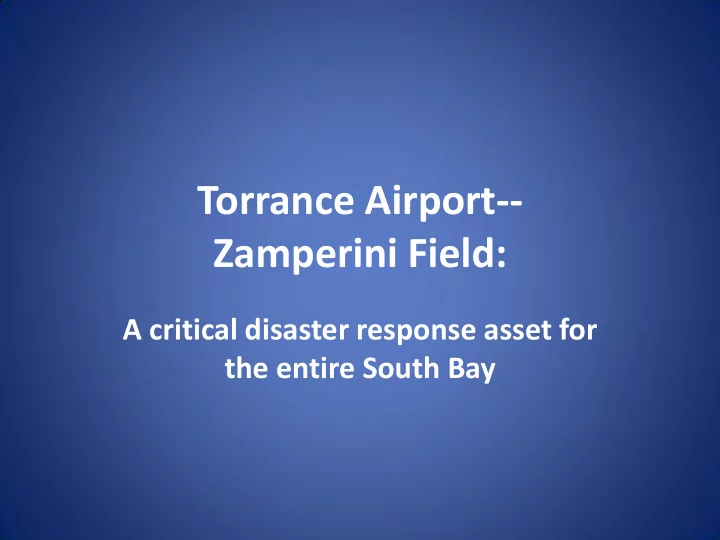

Torrance Airport-- Zamperini Field: A critical disaster response asset for the entire South Bay
“In a disaster, an airport can substitute for almost anything else, but nothing can substitute for an airport.” From “AVIATION CRITICAL INFRASTRUCTURE, AIRPORTS & CATASTROPHES”, Jim Smith, PhD, P.E. American Public University System
FEMA NATIONAL Level Exercise 2011-- Important findings • Transportation support and control were inefficient and inadequate • Air Traffic Control is critical — needs support • Patient movement capability is insufficient at Federal level • “Rotary -wing aircraft will be an incredibly important asset ” • Private sector resources must be seamlessly integrated into existing resourcing systems
Critical Role of General Aviation • Airborne search and rescue; • Medical evacuation; • Moving emergency medical supplies and emergency personnel; • Transport firefighting and law enforcement; • Damage assessment and resource needs assessment, particularly related to other critical infrastructure and hazardous materials incidents; • Media and VIP transport Source: Association of Bay Area Governments report 2013
Current Practice From the California Disaster Recovery Report, requested by Colette Armao, Division of Aeronautics, December 16, 2009 • GA airports have generally not been integrated into regional disaster response and recovery planning, and aviation-related response and recovery is often ad hoc, with the most coordinated entities being volunteer pilot organizations, firefighting agencies, and MedEvac organizations. • The primary emergency role of GA airports and heliports during a disaster is to a) create a safe environment for the various aircraft that will use them during a disaster and b) ensure that fuel and other resources are available for operating aircraft.
Planning and Challenges From the California Disaster Recovery Report, requested by Colette Armao, Division of Aeronautics, December 16, 2009 • Awareness and outreach are two of the primary challenges facing the integration of GA airports into disaster response and recovery planning. The local community and its officials must be aware of the presence of these airports and define the role they will play in a disaster. • Response planning should involve systems that facilitate communication, not top-down control structures that can impede it.
Gaps From the California Disaster Recovery Report, requested by Colette Armao, Division of Aeronautics, December 16, 2009 • General aviation has yet to be explicitly incorporated into most disaster response and recovery planning, and there is a dearth of detailed research on this topic. • FEMA is developing guidance that may help states in developing more comprehensive plans
A Network of Disaster Relief & Recovery Assets H H LAX Hawthorne H H H H H H Fullerton Compton H Goodyear H H H H Long Beach H H H H Torrance H H H H H H H HOSPITALS H HOSPITALS Los Alamitos AIRPORTS Region 1 Logistics Center
Torrance Airport Assets • Stand-by city emergency operations center • Logistics base for aircraft & helicopters – Aircraft arrival/departure – Transfer between helicopters and fixed-wing aircraft – Loading patients for transport – Off-loading medical personnel, supplies, equipment • Storage, triage, non-critical treatment – Storage areas on ramps & taxiways – Temporary shelters (tents, trailers) on ramps, taxiways, airfield – Existing shelter (hangars, GAC, Robinson factory) • Links to ground transportation – Gate access to PCH, Hawthorne Blvd, Crenshaw Blvd • Emergency power for critical systems • Local pilots and aircraft organized for transportation support • Robinson Helicopter Company pilots and helicopters
Torrance Airport — Zamperini Field L A HARBOR CRENSHAW HANGARS PCH ROBINSON TENTS, TRAILERS GAC HANGARS STORAGE SURFACES 5000’ LIGHTED, ILS RUNWAY HELIPORT
Airport Details • North Runway 29R/11L – 5001 feet long; 150 wide; lighted – 30,000 lb/single wheel; 50,000 double wheel; 90,000 double tandem – Instrument Landing System (ILS) • 29R: 300 AGL ceiling; 3/4 mi visibility • 11L (circling): 630 MSL ceiling; 1 mile visibility • South Runway 29L/11R – 3000 ft long; 75 ft wide; lighted – 20,000 single wheel • Helipad: – 110 ft X 110 ft, perimeter lights
Ramp Details • Asphalt surface • Main ramp: 160 ft X 4900 ft – Used for parking, off-loading and on-loading aircraft & helicopters – Access to ground transport: gates at ends and middle • West ramp: 980 ft X 100 ft – Could be used for storage or trailers • 2 High-speed taxiways: 1200 ft X 50 ft – Could be used for storage or trailers
What TAA has done • 7/9/2015: Briefed Torrance Memorial Emergency Management Team • 7/22/2015: Briefed South Bay Disaster Resource Center • 7/29/2015: Briefed Torrance Police Emergency Services Coordinator • 11/2/2015: Met with Torrance Fire Department Response has been enthusiastic
Recommend
More recommend